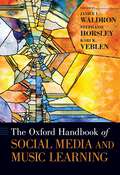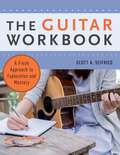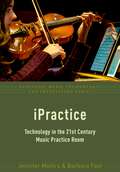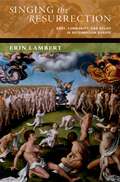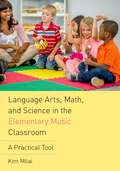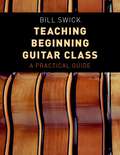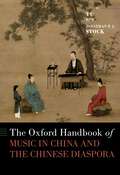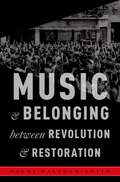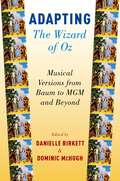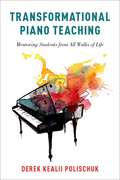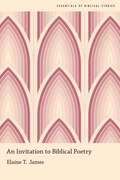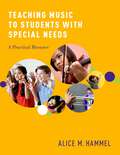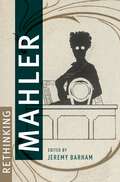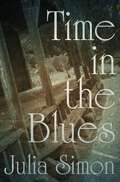- Table View
- List View
The Oxford Handbook of Social Media and Music Learning (Oxford Handbooks)
by Janice L. Waldron Stephanie Horsley Kari K. VeblenThe rapid pace of technological change over the last decade, particularly the rise of social media, has deeply affected the ways in which we interact as individuals, in groups, and among institutions to the point that it is difficult to grasp what it would be like to lose access to this everyday aspect of modern life. The Oxford Handbook of Social Media and Music Learning investigates the ways in which social media is now firmly engrained in all aspects of music education, providing fascinating insights into the ways in which social media, musical participation, and musical learning are increasingly entwined. In five sections of newly commissioned chapters, a refreshing mix of junior and senior scholars tackle questions concerning the potential for formal and informal musical learning in a networked society. Beginning with an overview of community identity and the new musical self through social media, scholars explore intersections between digital, musical, and social constructs including the vernacular of born-digital performance, musical identity and projection, and the expanding definition of musical empowerment. The fifth section brings this handbook to full practical fruition, featuring firsthand accounts of digital musicians, students, and teachers in the field. The Oxford Handbook of Social Media and Music Learning opens up an international discussion of what it means to be a musical community member in an age of technologically mediated relationships that break down the limits of geographical, cultural, political, and economic place.
The Guitar Workbook: A Fresh Approach to Exploration and Mastery
by Scott SeifriedIncreasingly, guitar study is offered alongside band, orchestra, and chorus in school music programs. This development has drawn a new population of students into those programs but has left music educators scrambling to developing meaningful, sequential courses of study that both meet the needs of these new students and align with state, county, and national curricula. Few available guitar methods are designed with the classroom in mind, and fewer still take a holistic approach to teaching and learning the instrument. In short, teachers are left to navigate a vast array of method books that cover a variety of styles and approaches, often without the confidence and experience necessary to know 'what to teach when.' The Guitar Workbook: A Fresh Approach to Exploration and Mastery addresses the needs of these educators. Throughout the book's 20 lessons, students are encouraged to explore the ways various guitar styles and notation systems differ, as well as the ways they support and complement each other. Lessons cover myriad topics including pick-style playing, basic open position chords, finger-style technique, and power chords. Suggested 'Mastery Activities' at the end of each lesson support higher-order thinking, contextualize the skills and concepts studied, and provide a jumping off point for further exploration. Additionally, suggestions for further study point teachers and students to resources for extra practice.
GUITAR WORKBOOK C: A Fresh Approach to Exploration and Mastery
by Scott SeifriedIncreasingly, guitar study is offered alongside band, orchestra, and chorus in school music programs. This development has drawn a new population of students into those programs but has left music educators scrambling to developing meaningful, sequential courses of study that both meet the needs of these new students and align with state, county, and national curricula. Few available guitar methods are designed with the classroom in mind, and fewer still take a holistic approach to teaching and learning the instrument. In short, teachers are left to navigate a vast array of method books that cover a variety of styles and approaches, often without the confidence and experience necessary to know 'what to teach when.' The Guitar Workbook: A Fresh Approach to Exploration and Mastery addresses the needs of these educators. Throughout the book's 20 lessons, students are encouraged to explore the ways various guitar styles and notation systems differ, as well as the ways they support and complement each other. Lessons cover myriad topics including pick-style playing, basic open position chords, finger-style technique, and power chords. Suggested 'Mastery Activities' at the end of each lesson support higher-order thinking, contextualize the skills and concepts studied, and provide a jumping off point for further exploration. Additionally, suggestions for further study point teachers and students to resources for extra practice.
iPractice: Technology in the 21st Century Music Practice Room (Essential Music Technology:The Prestissimo Series)
by Jennifer Mishra Barbara FastThis book provides new practical tools that bridge the gap between familiar, easy-to-use technology and musical practice to enhance musicianship and motivate students. Authors Jennifer Mishra and Barbara Fast provide ideas for use with students of all levels, from beginners to musicians performing advanced repertoire. This book is written for teachers (both studio teachers and ensemble directors), but can be read by performers to help give new guidance to their own practice sessions. Some strategies in this book would not have been possible without advances in technology; others expand tried-and-true practice strategies with the use of technology. Most of the technologies discussed are free or inexpensive and don't require extensive specialist equipment or learning. Rather than replacing quality practice strategies, technology brings new tools to the practicing tool box. The strategies lay the foundation for how technology can be used in the practice room and are intended to spark creativity. The book encourages teachers and students to vary the integration of practice strategies with technology in personal ways to fit their own studios or practice routines. This book is all about exploring our musical practice through technology. The ideas in this book will invigorate your musical practice and lead to even more creativity between you and your students
IPRACTICE TECHNOLOGY IN 21ST CENT EMT C: Technology in the 21st Century Music Practice Room (Essential Music Technology:The Prestissimo Series)
by Jennifer Mishra Barbara FastThis book provides new practical tools that bridge the gap between familiar, easy-to-use technology and musical practice to enhance musicianship and motivate students. Authors Jennifer Mishra and Barbara Fast provide ideas for use with students of all levels, from beginners to musicians performing advanced repertoire. This book is written for teachers (both studio teachers and ensemble directors), but can be read by performers to help give new guidance to their own practice sessions. Some strategies in this book would not have been possible without advances in technology; others expand tried-and-true practice strategies with the use of technology. Most of the technologies discussed are free or inexpensive and don't require extensive specialist equipment or learning. Rather than replacing quality practice strategies, technology brings new tools to the practicing tool box. The strategies lay the foundation for how technology can be used in the practice room and are intended to spark creativity. The book encourages teachers and students to vary the integration of practice strategies with technology in personal ways to fit their own studios or practice routines. This book is all about exploring our musical practice through technology. The ideas in this book will invigorate your musical practice and lead to even more creativity between you and your students
Singing the Resurrection: Body, Community, and Belief in Reformation Europe (The New Cultural History of Music Series)
by Erin LambertSinging the Resurrection brings music to the foreground of Reformation studies, as author Erin Lambert explores song as a primary mode for the expression of belief among ordinary Europeans in the sixteenth century, for the embodiment of individual piety, and the creation of new communities of belief. Together, resurrection and song reveal how sixteenth-century Christians--from learned theologians to ordinary artisans, and Anabaptist martyrs to Reformed Christians facing exile--defined belief not merely as an assertion or affirmation but as a continuous, living practice. Thus these voices, raised in song, tell a story of the Reformation that reaches far beyond the transformation from one community of faith to many. With case studies drawn from each of the major confessions of the Reformation--Lutheran, Anabaptist, Reformed, and Catholic--Singing the Resurrection reveals sixteenth-century belief in its full complexity.
Singing the Resurrection: Body, Community, and Belief in Reformation Europe (The New Cultural History of Music Series)
by Erin LambertSinging the Resurrection brings music to the foreground of Reformation studies, as author Erin Lambert explores song as a primary mode for the expression of belief among ordinary Europeans in the sixteenth century, for the embodiment of individual piety, and the creation of new communities of belief. Together, resurrection and song reveal how sixteenth-century Christians--from learned theologians to ordinary artisans, and Anabaptist martyrs to Reformed Christians facing exile--defined belief not merely as an assertion or affirmation but as a continuous, living practice. Thus these voices, raised in song, tell a story of the Reformation that reaches far beyond the transformation from one community of faith to many. With case studies drawn from each of the major confessions of the Reformation--Lutheran, Anabaptist, Reformed, and Catholic--Singing the Resurrection reveals sixteenth-century belief in its full complexity.
Language Arts, Math, and Science in the Elementary Music Classroom: A Practical Tool
by Kim MilaiLanguage Arts, Math, and Science in the Elementary Music Classroom provides a practical guide to help music teachers incorporate elementary classroom subjects into their curriculum using STEAM (Science, Technology, Engineering, Arts and Math)-inspired strategies, with added emphasis on social studies. It includes a complete elementary music curriculum for kindergarten, first, and second grades, and has cross-referencing charts for regular elementary classroom teachers to find music activities for their classroom. Importantly, it shows teachers how to include the artistic processes of creating, performing, responding, and connecting in their lessons. These processes make up the new music standards featured in NAfME's new Core Arts Music Standards. In order to maximize comprehension, the book includes assessment tests, sheet music, work sheet templates, and brainstorming activities centered on using technology to enhance composition projects. Lesson plans are organized by the calendar year, each inspired by the seasons, American culture, and world culture. These lessons may be used as is or used to generate new curricula altogether.
LANG ARTS, MATH & SCI ELEM MUS CLASS C: A Practical Tool
by Kim MilaiLanguage Arts, Math, and Science in the Elementary Music Classroom provides a practical guide to help music teachers incorporate elementary classroom subjects into their curriculum using STEAM (Science, Technology, Engineering, Arts and Math)-inspired strategies, with added emphasis on social studies. It includes a complete elementary music curriculum for kindergarten, first, and second grades, and has cross-referencing charts for regular elementary classroom teachers to find music activities for their classroom. Importantly, it shows teachers how to include the artistic processes of creating, performing, responding, and connecting in their lessons. These processes make up the new music standards featured in NAfME's new Core Arts Music Standards. In order to maximize comprehension, the book includes assessment tests, sheet music, work sheet templates, and brainstorming activities centered on using technology to enhance composition projects. Lesson plans are organized by the calendar year, each inspired by the seasons, American culture, and world culture. These lessons may be used as is or used to generate new curricula altogether.
Teaching Beginning Guitar Class: A Practical Guide
by Bill SwickAs guitar instruction increases in popularity in secondary schools, many band, choir, and orchestra teachers are asked to teach guitar. In one helpfully concise volume, Teaching Beginning Guitar Class: A Practical Guide provides all of the practical tools that are necessary to teach guitar in the classroom, especially for music instructors who are not guitar specialists. Formatted to follow the school year from summer planning to opening weeks of the fall semester to a week-to-week timeline for the full school year, Teaching Beginning Guitar Class encompasses all possible needs for a non-guitar playing music instructor navigating the world of guitar instruction in a classroom setting. In twelve expertly organized chapters, author and veteran guitar teacher Bill Swick gives hard and fast guides for instruction, providing reassurance alongside invaluable tips for novice guitar educators. This book addresses questions such as 'I Do Not Play Guitar, Why Do I have to Teach Guitar?'; 'What is the Classroom Lifespan of a Guitar?'; and 'New Students in January?' while also providing practical solutions including basic setup, how to select the correct method book, and equipment maintenance.
TEACHING BEGINNING GUITAR CLASS C: A Practical Guide
by Bill SwickAs guitar instruction increases in popularity in secondary schools, many band, choir, and orchestra teachers are asked to teach guitar. In one helpfully concise volume, Teaching Beginning Guitar Class: A Practical Guide provides all of the practical tools that are necessary to teach guitar in the classroom, especially for music instructors who are not guitar specialists. Formatted to follow the school year from summer planning to opening weeks of the fall semester to a week-to-week timeline for the full school year, Teaching Beginning Guitar Class encompasses all possible needs for a non-guitar playing music instructor navigating the world of guitar instruction in a classroom setting. In twelve expertly organized chapters, author and veteran guitar teacher Bill Swick gives hard and fast guides for instruction, providing reassurance alongside invaluable tips for novice guitar educators. This book addresses questions such as 'I Do Not Play Guitar, Why Do I have to Teach Guitar?'; 'What is the Classroom Lifespan of a Guitar?'; and 'New Students in January?' while also providing practical solutions including basic setup, how to select the correct method book, and equipment maintenance.
The Oxford Handbook of Music in China and the Chinese Diaspora (OXFORD HANDBOOKS SERIES)
In The Oxford Handbook of Music in China and the Chinese Diaspora, twenty-three scholars advance knowledge and understandings of Chinese music studies. Each contribution develops a theoretical model to illuminate new insights into a key musical genre or context. This handbook is categorized into three parts. In Part One, authors explore the extensive, remarkable, and polyvocal historical legacies of Chinese music. Ranging from archaeological findings to the creation of music history, chapters address enduring historical practices and emerging cultural expressions. Part Two focuses on evolving practice across a spectrum of key instrumental and vocal genres. Each chapter provides a portrait of musical change, tying musical transformations to the social dimensions underpinning that change. Part Three responds to the role that prominent issues, including sexuality, humanism, the amateur, and ethnicity, play in the broad field of Chinese music studies. Scholars present systematic orientations for researchers in the third decade of the twenty-first century. This volume incorporates extensive input from researchers based in China, Taiwan, and among Chinese communities across the world. Using a model of collaborative inquiry, The Oxford Handbook of Music in China and the Chinese Diaspora features diverse insider voices alongside authors positioned across the anglophone world.
The Oxford Handbook of Music in China and the Chinese Diaspora (OXFORD HANDBOOKS SERIES)
by Yu Hui and Jonathan P. J. StockIn The Oxford Handbook of Music in China and the Chinese Diaspora, twenty-three scholars advance knowledge and understandings of Chinese music studies. Each contribution develops a theoretical model to illuminate new insights into a key musical genre or context. This handbook is categorized into three parts. In Part One, authors explore the extensive, remarkable, and polyvocal historical legacies of Chinese music. Ranging from archaeological findings to the creation of music history, chapters address enduring historical practices and emerging cultural expressions. Part Two focuses on evolving practice across a spectrum of key instrumental and vocal genres. Each chapter provides a portrait of musical change, tying musical transformations to the social dimensions underpinning that change. Part Three responds to the role that prominent issues, including sexuality, humanism, the amateur, and ethnicity, play in the broad field of Chinese music studies. Scholars present systematic orientations for researchers in the third decade of the twenty-first century. This volume incorporates extensive input from researchers based in China, Taiwan, and among Chinese communities across the world. Using a model of collaborative inquiry, The Oxford Handbook of Music in China and the Chinese Diaspora features diverse insider voices alongside authors positioned across the anglophone world.
Music and Belonging Between Revolution and Restoration (Critical Conjunctures in Music and Sound)
by Naomi Waltham-SmithIn what ways is music implicated in the politics of belonging? How is the proper at stake in listening? What role does the ear play in forming a sense of community? Music and Belonging argues that music, at the level of style and form, produces certain modes of listening that in turn reveal the conditions of belonging. Specifically, listening shows the intimacy between two senses of belonging: belonging to a community is predicated on the possession of a particular property or capacity. Somewhat counter-intuitively, Waltham-Smith suggests that this relation between belonging-as-membership and belonging-as-ownership manifests itself with particular clarity and rigor at the very heart of the Austro-German canon, in the instrumental music of Haydn, Mozart, and Beethoven. Music and Belonging provocatively brings recent European philosophy into contact with the renewed music-theoretical interest in Formenlehre, presenting close analyses to show how we might return to this much-discussed repertoire to mine it for fresh insights. The book's theoretical landscape offers a radical update to Adornian-inspired scholarship, working through debates over relationality, community, and friendship between Derrida, Nancy, Agamben, Badiou, and Malabou. Borrowing the deconstructive strategies of closely reading canonical texts to the point of their unraveling, the book teases out a new politics of listening from processes of repetition and liquidation, from harmonic suppressions and even from trills. What emerges is the enduring political significance of listening to this music in an era of heightened social exclusion under neoliberalism.
Music and Belonging Between Revolution and Restoration (Critical Conjunctures in Music and Sound)
by Naomi Waltham-SmithIn what ways is music implicated in the politics of belonging? How is the proper at stake in listening? What role does the ear play in forming a sense of community? Music and Belonging argues that music, at the level of style and form, produces certain modes of listening that in turn reveal the conditions of belonging. Specifically, listening shows the intimacy between two senses of belonging: belonging to a community is predicated on the possession of a particular property or capacity. Somewhat counter-intuitively, Waltham-Smith suggests that this relation between belonging-as-membership and belonging-as-ownership manifests itself with particular clarity and rigor at the very heart of the Austro-German canon, in the instrumental music of Haydn, Mozart, and Beethoven. Music and Belonging provocatively brings recent European philosophy into contact with the renewed music-theoretical interest in Formenlehre, presenting close analyses to show how we might return to this much-discussed repertoire to mine it for fresh insights. The book's theoretical landscape offers a radical update to Adornian-inspired scholarship, working through debates over relationality, community, and friendship between Derrida, Nancy, Agamben, Badiou, and Malabou. Borrowing the deconstructive strategies of closely reading canonical texts to the point of their unraveling, the book teases out a new politics of listening from processes of repetition and liquidation, from harmonic suppressions and even from trills. What emerges is the enduring political significance of listening to this music in an era of heightened social exclusion under neoliberalism.
Adapting The Wizard of Oz: Musical Versions from Baum to MGM and Beyond
One of the most beloved film musicals of all time, The Wizard of Oz represents an enduring family favorite and cultural classic. Yet there is much more to the story than meets the eye, and the MGM movie is just one of many ways in which it has been represented. In this lively and wide-ranging book, editors Danielle Birkett and Dominic McHugh bring together insights from eleven experts into the varied musical forms this great American myth has taken in the past century. Starting with the early adaptations of L. Frank Baum's story, the book also explores the writing, composition and reception of the MGM film, its importance in queer culture, stage adaptations of the movie, cult classic The Wiz, Stephen Schwartz's Broadway blockbuster Wicked, and the cultural afterlife of the iconic Arlen-Harburg songs. What emerges is a vivid overview of how music - on stage and screen - has been an essential part of the story's journey to become a centerpiece of American culture.
ADAPTING WIZARD OF OZ C: Musical Versions from Baum to MGM and Beyond
by Danielle Birkett and Dominic McHughOne of the most beloved film musicals of all time, The Wizard of Oz represents an enduring family favorite and cultural classic. Yet there is much more to the story than meets the eye, and the MGM movie is just one of many ways in which it has been represented. In this lively and wide-ranging book, editors Danielle Birkett and Dominic McHugh bring together insights from eleven experts into the varied musical forms this great American myth has taken in the past century. Starting with the early adaptations of L. Frank Baum's story, the book also explores the writing, composition and reception of the MGM film, its importance in queer culture, stage adaptations of the movie, cult classic The Wiz, Stephen Schwartz's Broadway blockbuster Wicked, and the cultural afterlife of the iconic Arlen-Harburg songs. What emerges is a vivid overview of how music - on stage and screen - has been an essential part of the story's journey to become a centerpiece of American culture.
Transformational Piano Teaching: Mentoring Students from All Walks of Life
by Derek Kealii PolischukTransformational Piano Teaching: Mentoring Students from All Walks of Life examines the concept of the piano teacher as someone who is more than just a teacher of a musical skill, but also someone who wields tremendous influence on the development of a young person's artistic and empathic potential, as well as their lifelong personal motivational framework. The specific attributes of today's students are explored, including family and peer influences from interpersonal relationships to social media. Additionally, students from specific circumstances are discussed, including those with special needs such as Autism Spectrum Disorders, ADHD, and Depression. Finally, motivation of a teacher's students is related to a teacher's own motivation in their work, as a cycle of positivity and achievement will be recommended as a way to keep an instructor's work fresh and exciting.
TRANSFORMATIONAL PIANO TEACHING C: Mentoring Students from All Walks of Life
by Derek Kealii PolischukTransformational Piano Teaching: Mentoring Students from All Walks of Life examines the concept of the piano teacher as someone who is more than just a teacher of a musical skill, but also someone who wields tremendous influence on the development of a young person's artistic and empathic potential, as well as their lifelong personal motivational framework. The specific attributes of today's students are explored, including family and peer influences from interpersonal relationships to social media. Additionally, students from specific circumstances are discussed, including those with special needs such as Autism Spectrum Disorders, ADHD, and Depression. Finally, motivation of a teacher's students is related to a teacher's own motivation in their work, as a cycle of positivity and achievement will be recommended as a way to keep an instructor's work fresh and exciting.
An Invitation to Biblical Poetry (Essentials of Biblical Studies)
by Elaine T. JamesAn Invitation to Biblical Poetry is an accessibly written introduction to biblical poetry that emphasizes the aesthetic dimensions of poems and their openness to varieties of context. It demonstrates the irreducible complexity of poetry as a verbal art and considers the intellectual work poems accomplish as they offer aesthetic experiences to people who read or hear them. Chapters walk the reader through some of the diverse ways biblical poems are organized through techniques of voicing, lineation, and form, and describe how the poems' figures are both culturally and historically bound and always dependent on later reception. The discussions consider examples from different texts of the Bible, including poems inset in prose narratives, prophecies, psalms, and wisdom literature. Each chapter ends with a reading of a psalm that offers an acute example of the dimension under discussion. Students and general readers are invited to richer and deeper readings of ancient poems and the subjects, problems, and convictions that occupy their imagination.
An Invitation to Biblical Poetry (Essentials of Biblical Studies)
by Elaine T. JamesAn Invitation to Biblical Poetry is an accessibly written introduction to biblical poetry that emphasizes the aesthetic dimensions of poems and their openness to varieties of context. It demonstrates the irreducible complexity of poetry as a verbal art and considers the intellectual work poems accomplish as they offer aesthetic experiences to people who read or hear them. Chapters walk the reader through some of the diverse ways biblical poems are organized through techniques of voicing, lineation, and form, and describe how the poems' figures are both culturally and historically bound and always dependent on later reception. The discussions consider examples from different texts of the Bible, including poems inset in prose narratives, prophecies, psalms, and wisdom literature. Each chapter ends with a reading of a psalm that offers an acute example of the dimension under discussion. Students and general readers are invited to richer and deeper readings of ancient poems and the subjects, problems, and convictions that occupy their imagination.
Teaching Music to Students with Special Needs: A Practical Resource
by Alice M. HammelTeaching Music to Students with Special Needs: A Practical Resource brings together theory, policy, and planning for instruction in K-12 classrooms. The resource is a result of collaboration between K-12 teachers, outstanding undergraduate and graduate music education students, and professionals in the field. The lesson ideas, lesson plans, and unit plans are organized according to the six domains posited by Alice Hammel and Ryan Hourigan in their book, Teaching Music to Students with Special Needs: A Label-free Approach, Second Edition. This book equips music educators with understanding necessary to implement teaching ideas into the domains of cognition, communication, behavior, emotions, and physical and sensory needs. Classroom-tested lesson plans include procedure outlines and assessments as well as guides for adaptation, accommodation, and modification needed for successful implementation in K-12 classrooms. As such, this eminently useful guide provides teachers with enough practical ideas to allow them to begin to create and adapt their own lesson plans for use with students of differing needs and abilities.
Teaching Music to Students with Special Needs: A Practical Resource
by Alice M. HammelTeaching Music to Students with Special Needs: A Practical Resource brings together theory, policy, and planning for instruction in K-12 classrooms. The resource is a result of collaboration between K-12 teachers, outstanding undergraduate and graduate music education students, and professionals in the field. The lesson ideas, lesson plans, and unit plans are organized according to the six domains posited by Alice Hammel and Ryan Hourigan in their book, Teaching Music to Students with Special Needs: A Label-free Approach, Second Edition. This book equips music educators with understanding necessary to implement teaching ideas into the domains of cognition, communication, behavior, emotions, and physical and sensory needs. Classroom-tested lesson plans include procedure outlines and assessments as well as guides for adaptation, accommodation, and modification needed for successful implementation in K-12 classrooms. As such, this eminently useful guide provides teachers with enough practical ideas to allow them to begin to create and adapt their own lesson plans for use with students of differing needs and abilities.
Rethinking Mahler
by Jeremy BarhamAs one of the most popular classical composers in the performance repertoire of professional and amateur orchestras and choirs across the world, Gustav Mahler continues to generate significant interest, and the global appetite for his music, and for discussions of it, remains large. Editor Jeremy Barham brings together leading and emerging scholars in the field to explore Mahler's relationship with music, media, and ideas past and present, addressing issues in structural analysis, performance, genres of stage, screen and literature, cultural movements, aesthetics, history/historiography and temporal experience. Rethinking Mahler counterbalances prevailing scholarly assumptions and preferences that configure Mahler as proto-modernist, with hitherto neglected consideration of his debt to, and his re-imagining of, the legacies of his own historical past. Over the course of 17 chapters drawing from a variety of disciplinary perspectives, the book pursues ideas of nostalgia, historicism and 'pastness' in relation to an emergent modernity and subsequent musical-cultural developments, yielding a wide-ranging exploration and re-evaluation of Mahler's works, their historical reception and understanding, and their resounding impact within diverse cultural contexts. Rethinking Mahler will be an essential resource for scholars and students of Mahler and late Romantic era music more generally, and will also find an audience among the many devotees of Mahler's music.
Time in the Blues
by Julia SimonSpontaneity, immediacy and feeling characterize the blues as a genre. Whether it's the movement of call and response, the expressive bends and wails of voice and instruments or the synergistic relationship between audience and performers, the blues embody a kind of "living in the moment" aesthetic. At the same time, the blues genre has always responded in a unique way to its historical moment, its formal characteristics, figures, and devices constantly emerging from--and speaking to--the social relations emanating from Jim Crow segregation, sharecropping, racist violence, and migration. Time in the Blues presents an interdisciplinary analysis of the specific forms of temporality produced by and reflected in the blues. Examining time as it is represented, enacted, and experienced through the blues, interdisciplinary scholar Julia Simon addresses how the material conditions in the early twentieth century shaped a musical genre. The technical aspects of the blues--ostinato patterns, cyclical changes, improvisation, call and response--emerge from and speak to the Jim Crow era's economic, social, and political relations. Through this temporal analysis, Simon addresses how the moment-to-moment aspect of time in blues performance relates to the genre's location within historical time, with careful examinations of the historical performance and reception of blues music from the 1920s to the present day. Simon examines the structuring of time, and analyzes temporality to open the broader questions of desire, agency, self-definition, faith, and forms of resistance as they are articulated in this music. Ultimately, Time in the Blues, argues for the relevance, significance, and importance of time in the blues for shared values of community and a vision of social justice.
